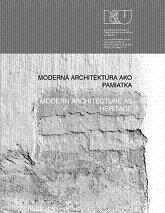MALÝ MODERNÝ DOM / DOMOV AKO PAMIATKA
SMALL MODERN HOUSE / HOME AS MONUMENT
Author(s): Maria TopolčanskáSubject(s): Cultural Essay, Political Essay, Societal Essay
Published by: Historický ústav SAV, v. v. i.
Keywords: everyday use; modern; house; housing; preservation; Partizánske; Baťa
Summary/Abstract: Everyday living in modern architecture houses – especially energy losses via old structures – often become the first arguments (on the side of most actors of their protection and realization of their maintenance, not exclusively inhabitants) against their proclamation to become cultural monuments or part of protected zones. The most standard situation is selection of unique iconic housing buildings (usually villas) and making them musified examples of what architecture in modern terms once was and „looked like“. Exhibiting curated modern houses means providing authentic reality but without authentic function, more than authenticity they become documents and monuments in pure sense. The approach applied in such curated houses and villas becoming museums are inconsistent with situation when continuous use in original function – that is inhabiting – takes place in the modern house today. One can hardly occupy a period room. This approach is inapplicable in cases of less unique but more universal examples of modern housing – social housing in apartment buildings or family houses in workers quarters of modernist cities. How much the everyday use value and architecture value worth protection overlap; how to make conservation of recent everyday feasible practically and economically; how to make the lived life of a place of modern architecture monument and its conservation interventions consistent? In the case of key exemples (e.g. Vila Tugendhat) the outcome oscillates between representation and simulation. The text turns back to the theoretical texts by Anthony Vilder and Karel Teige on paradoxes intrinsic to modernism. Vidler´s research on the notions of the uncanny or ‘unhomely’ versus the homely in modern architecture and his definition of nostalgia produced as a reaction to the ‘geometric cube’ houses of modernism are relevant to distinguish the state of modern houses to be musified or listed and occupied. Teige´s paradox of constructivist and poetic complements of the modern culture is here rather freely used as a reference leading to identify what is potentially “structural” and what is “spontaneous, lively” in the avant-guard housing, designed than in the „style of the present“ promoting their key value to be „newness“. The question arises on what the act of preservation has to do with ideals of modernism and its avant-guard that were opposed to any historicism a and resistent to admit conservation conceptually. These conceptual roots of houses that are today object of our interest to save their key values against unevitable entropy are important to be recalled to provide a solution for everyday use of those modern housing buildings that are maybe less unique than the individually and totally conservated works (usually modern villas) but worth protecting exactly for their universal values produced in series (usually social and worker´s modern housing). Conservation as an approach applied in unique cases has its feasible parallel in consistency
Journal: Architektúra & Urbanizmus
- Issue Year: 44/2010
- Issue No: 3-4
- Page Range: 352-361
- Page Count: 10
- Language: Slovak

